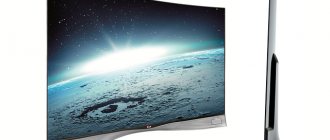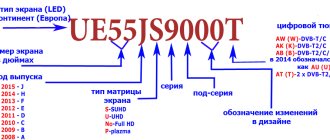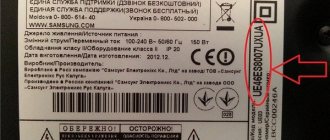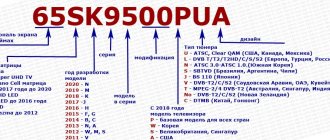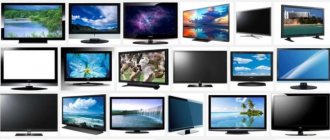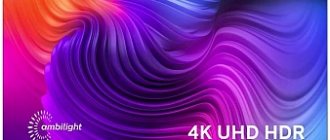Diagonal size
The numbers in front of the marking indicate the screen diagonal in inches. An inch equals 2.54 cm. The price of TVs fluctuates depending on the diagonal size, and even a small increase in size can have a big impact financially. Therefore, before purchasing, you need to calculate the area of the room where the TV receiver will be installed. The most popular TVs on the market are from 32 to 55 inches.
UHD 4K
This model range features ultra-high 4K resolution. The resolution format deserves special attention, but also the presence of expanded dynamic range - Active HDR. This is a unique development of the company.
A whole list of options for HDR content, there are both classic and HGL. The built-in HDR-effect function brings the picture quality as close as possible to the HDR 4K format. What is not affected by the quality of incoming content on the screen.
New TVs:
| Diagonal | Price |
| 43″ | from 520 dollars |
| 49″ | up to 900 dollars |
| 55″ | up to $1330 |
| 60″ | $1320 |
| 65″ | up to 2.5 thousand dollars |
| 75″ | up to 4.1 thousand dollars. |
All screens are equipped with an improved IPS matrix with Edge Lit Backlighting. This option supports local dimming.
Types of displays
Using the markings in the name of the television receiver, you can understand the display manufacturing technology: from liquid crystal displays to OLED displays. The display type can be identified by the letter that appears immediately after the screen diagonal value. Explanation of displays:
- E — OLED screen;
- U - LED displays with Ultra HD resolution;
- S - LCD displays with backlighting of Nano Cell quantum dots;
- L — LCD displays with LED backlighting and HD resolution;
- C - LCD with a liquid crystal matrix, the backlight is powered by a fluorescent lamp;
- R - Plasma.
The last 2 types of displays are not currently in production.
LG TV designations
The TV marking is usually indicated on the price tag, so you can find and decipher it even without the help of a sales assistant. For LG equipment it looks like this:
LG 00 AB 2 3 4 C, where:
- 00 - the first two digits indicate the size of the TV display (in inches);
- A - letter codes of the type of screen matrix;
- B is the letter code of the year when this model was developed;
- 2 - series to which the device belongs;
- 3 — serial number of the model in the series;
- 4 - a number indicating any changes in the design;
- C - letter code of the matrix type, its resolution, digital tuner.
Please note that the markings of LG OLED TVs are slightly different from those presented:
OLED 00 A 1 B, where:
- OLED - TV display type;
- 00 — screen diagonal in inches;
- A - number of a model with excellent design;
- 1 - the year when this model was presented by the developers;
- B — device tuner type.
Now you can move on to a more detailed analysis of each item.
Display size
Everything is simple here. The LG 42... TV is a device with a screen diagonal of 42 inches. For reference: 1 inch is 2.54 cm. The dimensions of the display have a direct impact on the price, so even a difference of a few inches can have a significant impact on the cost.
The fastest-selling models are with a diagonal of 32-50 inches. More and more buyers are opting for 55-inch screens. Therefore, the LG 42... TV, which we indicated in the example, is an average model in terms of these characteristics.
TV screen type
The second part of the model markings says the following:
- P - in front of you is a plasma panel.
- C - LCD (liquid crystal matrix TV) with fluorescent backlight.
- L - LCD TV with LED backlight (using LED lamps).
- U - LCD screen with LED backlight and Ultra HD resolution.
- E, EC - OLED display (until 2021, then such models began to be designated as OLED..., which we discussed in the previous section).
- S - innovation of 2021, Super UHD TV with a Nano Cell matrix (a super matrix with light-emitting particles whose size does not exceed 1 nanometer).
- (LG) LF - TVs with high-quality Full HD resolution.
- UF is a flat screen TV with 4K resolution.
- EF is an OLED TV with a flat display whose resolution is 4K.
- EG is an OLED TV, but with a concave screen, whose resolution is also at least 4K, and the matrix is four-color.
- UB is a device with a 4K screen resolution.
- UC is a TV with a concave C-curved display.
- LB - equipment has Full HD screen quality.
- LY is a special designation for commercial large TVs that are used in bars, hotels, supermarkets, etc.
LCD, plasma, OLED: advantages and disadvantages
Thus, today the company provides three main types of TVs:
- LCD (liquid crystal) - such a screen consists of an LCD matrix (liquid crystals located between polymers), light sources, wires, and a housing that gives rigidity. Each “liquid crystal” is two layers of polarizing filters, between which are electrodes, and between them, in turn, is a layer of molecules.
- Plasma (SED) - so-called gas discharge monitors. Their work is based on the glow of a phosphor under the influence of UV rays. The latter arise in ionized gas during the passage of an electric discharge.
- OLED is a type of screen made up of organic compounds that are capable of emitting light when an electric current passes through them.
Let's look at the main advantages and disadvantages of the presented LG TV models in the table.
| Variety | pros | Minuses |
| Liquid crystal displays |
|
|
| Plasma TVs |
|
|
| OLED displays |
The screen can fully operate in a wide range: -40 ... +70 °C. |
|
Having analyzed the features of the presented types of screens, we move on to deciphering the markings.
Year of development
The letter code corresponding in the labeling of LG TVs for the year of development of a particular model may be as follows:
- J - 2021.
- H - 2021.
- G, F - 2015.
- C, B - 2014.
- A, N - 2013.
- M, S, W - 2012.
- V - 2011.
LG TV series
Let's look at the LG TV series and their distinctive characteristics in the following table.
| Series | Description |
| 9 | The series is represented by models with widescreen (80-100 inches) screens, equipped with a maximum range of related accessories. |
| 8 | LG 3D TVs with a number of additional accessories, such as a webcam. |
| 7 | TVs that support 3D images and have improved screen quality characteristics. |
| 6 | LG 3D TVs with display diagonals up to 60 inches. |
| 5 | Regular but widescreen screen - 32-50 inches. |
| 4 | Televisions characterized by a small screen size (22-28 inches). |
Let's move on to the penultimate marking point.
Model number
The following two symbols in the LG TV markings mean the following:
- The first digit is the number of this model in the series from the subheading above.
- The second number highlights any design features of the TV you have chosen: color, design solution, shape of its stand, etc.
HD support and tuner
The last letter code will tell you about the capabilities of the matrix or tuner to support a certain resolution. Let's present this information in a table.
| Code | Format | Meaning |
| U, B | HD | The screen does not support Full HD; screen diagonal of at least 32 inches |
| O | DVB-C, DVB-T | |
| V | DVB-C, DVB-S2, DVB-T2 | Display resolution of at least 1920 x 1080 pixels |
| S | DVB-S2 | Supports satellite digital television format |
| C | DVB-C | Supports cable digital television format |
| T | DVB-T | Complies with the European digital terrestrial television standard |
The most “successful” code is, of course, V. Such televisions support all formats of TV broadcast in Russia and the CIS countries. In addition, this letter designates Full HD screens.
Tuner types
Let's tell you more about the voiced formats:
- DVB-C is a pan-European digital TV standard used by cable operators.
- DVB-S, DVB-S2 - the TV’s support for these digital TV formats means that to watch satellite channels you will only need a satellite dish and a special card from the provider. A special set-top box (receiver) is not needed.
- DVB-T, DVB-T2 - the first format of terrestrial digital TV (caught by a conventional remote antenna) is typical for the countries of the European Union, and the second - for Russia and the CIS countries. Although the T2 is an improved version of the T, they are not interchangeable.
That's all we wanted to tell you about the labeling of LG TVs. We hope that the information presented will help you make the right choice when purchasing, or you will learn a little more about the equipment you already have.
It goes without saying that the information indicated in the labeling should not contradict the characteristics of the product in its documents, warranty card, instructions - this state of affairs may be grounds for doubting the authenticity of the TV.
Source: https://monateka.com/article/245330/
Year of construction
After the abbreviation for the type of display, the markings indicate the year of manufacture of the TV. Each value differs not only in its release date, but also implies the presence of certain functions:
- 2019 - M for LCD; 9 for OLED;
- 2018 - K for LCD; 8 for OLED;
- 2017 - J for LCD; 7 for OLED;
- 2016 - N for LCD; 6 for OLED;
- 2015 - F flat screen; G for curved display;
- 2014 - B;
- 2013 – N, A (A with 3D function, N without 3D);
- 2012 – LW, LM, PA, PM, PS (LW and LM with 3D);
- 2011 – LV.
Characteristics of LG TVs, review of the best models
Over the past few years, LG TVs have been considered one of the most innovative devices. LG is the only company that produces OLED panels. And although other companies are not alien to the concept of “OLED TVs,” they create them based on displays from LG.
Last year, this South Korean company celebrated its anniversary - 50 years since the first TV was released. At one time, their black-and-white devices did not pretend to be anything, but in the 21st century, with their OLED technology, Korean TVs have proven themselves well and are not losing ground in the ratings.
How to understand the markings
LG has a huge range of TVs that can satisfy even the most demanding consumer and fit into the most modest budget. On the equipment market from this manufacturer you can find the following devices:
- 4K;
- 3D;
- with LED backlight;
- with OLED backlight;
- with curved screen;
- small-inch from 21.5″;
- large-sized - with a screen diagonal of 86″.
And these are not all the indicators that are skillfully encrypted on each TV. When a buyer thinks about how to choose an LG TV, then, first of all, you need to understand the decoding of a specific LG TV model.
Getting to know some general concepts will help you understand what lies behind the obscure abbreviations.
These are devices with a new standard for picture resolution - 8 million pixels. For comparison, Full HD has 2 million pixels. 4K TVs have increased clarity and a wide range of colors. This was appreciated not only by those who like to view content in extremely high resolution, but also by fans of computer games.
LED TV
This abbreviation is written in full “light - emitting diode”, which means “light emitting diode”. LED TVs are liquid crystal (LCD) devices. But if in LCD TVs the matrix is illuminated by fluorescent lamps, then in LEDs this function is performed by LEDs.
Buyers consider such devices as good because they have the following advantages:
- the thickness and weight of the TV decreases;
- moving objects are depicted without distortion;
- energy consumption is reduced by up to 40%;
- image contrast improves;
- there is no mercury in semiconductor chips;
- the service life of the device increases.
But these achievements do not stand still and are steadily developing.
OLED TVs
OLEDs are semiconductor chips (light emitting diodes) of organic nature. And the technology of the same name involves the use of appropriate LEDs in the assembly of monitors.
OLED displays are superior to LCD and LED in the following ways:
- even in brightly lit rooms the picture is not distorted;
- No noticeable distortion appears at different viewing angles;
- The picture is of good quality - contrast and brightness are high;
- expanded range of color palette.
In addition, the improvement of the technology is just beginning and there is every reason to believe that in the future OLED TVs will be superior to those models that are the first to go into mass production.
For example, a consumer decided to buy the LG 86UH955V model. The decoding of the marking will be as follows:
- The diagonal of the device is 86 inches.
- Matrix type - UHD-LED on liquid crystals with LED backlighting and Ultra HD resolution.
- The model began production in 2021.
- This device is from series 9. These are the largest screens with a diagonal of 80-100 inches, with 3D, multifunctional and with extended equipment.
- Model in the series - 5.
- Design version - 5.
- Tuner - DVB-S2/T2/C implies satellite television reception.
From a small abbreviation you can find out all the main technical characteristics of a particular LG TV model.
Model overview
When thinking about which TV to buy, consumers study many descriptions of various models, are interested in what position it occupies in the rating, as well as what other users who have already tested it think about a particular device.
LG 32LF653V
This is a 2021 3D TV with circular polarization. Both lenses in glasses have different directions - clockwise and counterclockwise, in which changing the tilt of the head does not affect the depth of the 3D effect.
Specifications:
- The 32″ screen diagonal is most in demand among middle class consumers. Although 42″ and 55″ are available with similar characteristics, but then the price increases accordingly.
- The screen resolution is 1920×1080.
- The device is a 3D TV with LED backlighting and passive 3D technology.
- Smart TV support is based on the WebOS 2.0 platform. Connecting external devices is very convenient.
- The device is equipped with two TV tuners - analog and digital.
- Rated power consumption - 70 W. And in standby mode - 0.3 W.
The IPS matrix provides a wide viewing angle. The main menu contains all services and content for entertainment. According to consumers, this is one of the best 3D TVs from LG. With fairly good characteristics, it remains affordable.
LG 40UF670V
This device is an ULTRA HD 4K TV. It is equipped with a digital DVB-T2 tuner and has a Virtual Surround sound system.
Positive characteristics:
- Incredibly clear Ultra HD screen.
- The unique 4K Upscaler algorithm allows you to scale the image to maximum clarity.
- The Motion Eye Care light sensor ensures that your eyes don't get tired while watching.
- Clear Voice II technology allows voices to be heard clearly and loudly.
- USB ports (2 pieces) and HDMI connectors (2 pieces) allow you to connect various external devices.
This LG 40″ TV model has won the love of many consumers.
LG 55UH620V
According to experts, this model is the golden mean in terms of quality and price. The TV has a stylish design, and the quality of internal and external workmanship is at a high level.
Functions and Features:
- The particularly thin ULTRA Slim design with innovative metal elements in the body saves space and fits seamlessly into any interior.
- The HDR Pro feature allows you to view the rich color gamut, down to the smallest shades, that were intended when shooting the material. This is possible thanks to three-dimensional color processing.
- It is possible to increase or decrease the screen brightness to save energy.
- A special sound wave conversion system creates the impression that the sound is 7-channel.
- An updated set of programs based on webOS 3.0 significantly improves the performance of Smart TV.
Consumers give this LED TV from LG high marks.
Series
Further in the marking the series and series number are used. The higher the number, the more technologies the TV supports. The series designation ranges from 4 to 9.
In addition, there is a difference in the selection of 3D functions and depends on the components used. The characteristics of the characteristics change every year and the older series may move into the junior category, so for complete information it is recommended to visit the official LG website.
After the series number in the markings, the values of the model in the series and model modifications follow. The higher the digital value, the better the TV's performance.
Super UHD 4K
This is the premium segment of LG. Here we present equipment with a new level of LCD TVs. NanoCell technology is used. The essence of the new method: a layer with nanoconductors is formed on the matrix, which absorb excess light from the diodes, and completely bring the picture closer to OLED.
The best TVs in this segment are represented by 4 models:
| Diagonal | Price |
| 49″ | $940 |
| 55″ | up to 1.9 thousand dollars |
| 65″ | up to 3.3 thousand dollars |
| 86″ | up to 8.7 thousand dollars. |
TV market specialists name these methods among major brand ones. SUHD TVs from LG are a response to QLED models produced by competing companies.
Despite the high prices, there is still something to pay for here.
Tuner
At the end of the marking, the tuner designation is used to receive the signal. The current markings are as follows:
- T - DVB-T/T2, DVB-C;
- S - DVB-T, DVB-C, DVB-S/S2;
- V - DVB-T/T2, DVB-C, DVB-S/S2;
- C - DVB-T, DVB-C.
To clearly illustrate the meaning of the marking, let’s take the LG 49SJ810V model. Detailed analysis of markings:
- 49 — diagonal value;
- S - liquid crystal matrix, and the backlight is quantum dots, 4K resolution;
- J — year of assembly 2017;
- 8 — series number;
- 1 and 0 - series modification, appearance values and differences in parameters are applied;
- V - tuner values.
Oled TV
The Oled line brings together the best from the manufacturer. In the process of developing screens, self-illuminating pixels based on organic light-emitting diodes are used. Here is the perfect black color. The image on the screen is bright, saturated, and has no reference to the corners.
The company's developers noted that the image will now be 25% brighter, which will improve color rendition.
| Diagonal | Price |
| 55″ | up to 2.9 thousand dollars |
| 65″ | up to 8.5 thousand dollars |
| 77″ | up to 22.3 thousand dollars. |
These truly have some of the best models in terms of hardware – 4K support, infinite contrast, 10-bit colors and HDR.
It should be said about the appearance of the TV. This is a truly chic design solution. Since it is a single-layer screen, which will surprise everyone with its thinness. Moreover, not everyone knows the image on the glass; the company also decided to stick to a seamless design.
Changes from 2021
Since 2021, LG has made some adjustments to the meaning of the label. The changes concern the final part of the marking, where the tuner value was located. Starting from 2021, this place is occupied by a symbol indicating the sales region, then the meaning of the tuner, and at the end a symbol indicating the design.
The symbols in the marking at the end look like this:
- R - Europe, USA;
- W - Korea;
- A - USA;
- S - UK, Singapore.
The following is the meaning of the tuner:
- U - ATSC, Clear QAM;
- L - DVB-T/T2/T2HD/C/S/S2;
- N - ATSC 3.0, ATSC 1.0;
- S—SBTVD;
- J - BS110.
The design code value is used at the end.
LED TV Samsung UE40H6233AK received a repair with a “dim image” defect
- Direct LED lighting
- LEDs for 3V, 1W - 27.03010
- Number of LEDs - 39 pcs.
- Lenses - small, droplets
- Substrate - aluminum
- Number of backlight driver channels - 3
Product code
The TV label contains additional information called Product Code. Now let’s learn about the decoding of this type of marking. The destination region for each TV model is individual:
- Z – Europe;
- U – Asia;
- T - East and Africa;
- N - North America;
- A – Australia;
- S - South America.
The second symbol indicates the design of the gadget. The third character indicates the country of manufacture of the TV board:
- A – Korea;
- In Russia;
- C – Czech Republic.
The fourth category of symbols indicates the country of destination of the gadget. Fifth in the list is the matrix value:
- Z - LG IPS, 120 Hz matrix;
- R - LG Display Co.Ltd. TN;
- W - LG Display Co.Ltd. S-IPS;
- Y - LG Display Co.Ltd. S-IPS;
- U - LG Display Co.Ltd. IPS WUN SAB1/SAB2;
- P - LG Display Co.Ltd. IPS WXN SBA1/SBA2;
- Q - LG Display Co.Ltd. IPS WXN SAA1/SAA2;
- V - LG Display Co.Ltd. IPS WUD SBA1/SBA2;
- G - CHI MEI OPTOELECTRONICS CORP. TN;
- H - CHI MEI OPTOELECTRONICS CORP. S-MVA;
- J - CHI MEI OPTOELECTRONICS CORP. S-MVA;
- D - AU OPTRONICS CORP. TN;
- T - AU OPTRONICS CORP. AMVA;
- M - SHARP CORPORATION VA;
- S - SHARP CORPORATION VA.
After these values, symbols are used to indicate the backlight; 2 types are available, L or W. The last symbols indicate the country of assembly of the gadget:
- JG – Poland;
- JU – Russia;
- LH – Korea;
- LA – Czech Republic.
